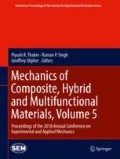Abstract
The addition of carbon nanotubes throughout the binder phase of energetic particulate composites is investigated in an effort to develop real-time embedded sensing networks for detection of small-scale damage in polymer bonded explosives undergoing mechanical load. The experimental effort herein focuses on the exploration of multi-walled carbon nanotube (MWCNT) concentration in energetic composite material; the fabrication of such specimen include the substitution of sugar as a mock energetic for the crystal particulate Ammonium Perchlorate (AP), an oxidizer most often used in solid rocket propellants. Further explored was the particulate embedded into a binder of PDMS, a polymeric silicone, as well as the addition of aluminum powder, a common combustive fuel in solid propellants, in the particulate. Electrical and mechanical properties of neat (no MWCNTs) energetics and MWCNT hybrid energetics were quantitatively evaluated under monotonic compression, and tension to failure. Noteworthy electro-mechanical response was obtained for these MWCNT AP hybrid energetics, justifying further study of CNT binder network formation for real-time electro-mechanical sensing in an effort for structural health monitoring (SHM) in energetics.
Access this chapter
Tax calculation will be finalised at checkout
Purchases are for personal use only
References
Siviour, C., Laity, P., Proud, W., Field, J., Porter, D., Church, P., Gould, P., Huntingdon-Thresher, W.: High strain rate properties of a polymer-bonded sugar: their dependence on applied and internal constraints. In: Proceedings of the Royal Society of London A: Mathematical, Physical and Engineering Sciences, No. 464, pp. 1229–1255 (2008)
Balzer, J.E., Siviour, C.R., Walley, S.M., Proud, W.G., Field, J.E.: Behaviour of ammonium perchlorate–based propellants and a polymer–bonded explosive under impact loading. Proc. Math. Phys. Eng. Sci. 460(2043), 781–806 (2004). https://doi.org/10.1098/rspa.2003.1188
Prakash, N., Seidel, G.D.: Effects of microscale damage evolution on piezoresistive sensing in nanocomposite bonded explosives under dynamic loading via electromechanical peridynamics. Model. Simul. Mater. Sci. Eng. 26(1), 015003 (2018). http://stacks.iop.org/0965-0393/26/i=1/a=015003
Sengezer, E., Seidel, G.: Structural health monitoring of nanocomposite bonded energetic materials through piezoresistive response. AIAA J. 56, 1–14 (2017)
Prakash, N., Seidel, G.D.: Computational electromechanical peridynamics modeling of strain and damage sensing in nanocomposite bonded explosive materials (NCBX). Eng. Fract. Mech. 177, 180–202 (2017). https://doi.org/10.1016/j.engfracmech.2017.04.003, http://www.sciencedirect.com/science/article/pii/S0013794416307007
Rocker, S., Wade Pearrell, T., Sengezer, E., Seidel, G.: Thermo-electromechanical response of polymer-bonded explosives for structural health monitoring of energetic materials, p. V001T01A009 (2017)
Chaurasia, A.K., Sengezer, E.C., Talamadupula, K.K., Povolny, S., Seidel, G.D.: Experimental characterization and computational modeling of deformation and damage sensing through the piezoresistive response of nanocomposite bonded surrogate energetic materials. J. Multifunct. Compos. 2, 227–253 (2014)
Talamadupula, K.K., Chaurasia, A.K., Seidel, G.D.: Multiscale Modeling of Effective Piezoresistivity and Damage Response in Nanocomposite Bonded Explosives (2017)
Prakash, N., Seidel, G.: Coupled electromechanical peridynamic modeling of strain and damage sensing in granular energetic materials. In: Conference: 58th AIAA/ASCE/AHS/ASC Structures, Structural Dynamics, and Materials Conference (2017). https://doi.org/10.2514/6.2017-0126
Sengezer, E.C., Seidel, G.D.: Real time in-situ sensing of damage evolution in nanocomposite bonded surrogate energetic materials. Proc. SPIE 9800, 9800–9810 (2016). https://doi.org/10.1117/12.2218856
Talamadupula, K.K., Chaurasia, A.K., Seidel, G.D.: 2-Scale hierarchical multiscale modeling of piezoresistive and damage response in polymer nanocomposite bonded explosive. In: ASME 2016 Conference on Smart Materials, Adaptive Structures and Intelligent Systems (2016). https://doi.org/10.1115/SMASIS2016-9234
Ku-Herrera, J., Avilés, F.: Cyclic tension and compression piezoresistivity of carbon nanotube/vinyl ester composites in the elastic and plastic regimes. Carbon 50(7), 2592–2598 (2012) https://doi.org/10.1016/j.carbon.2012.02.018, http://www.sciencedirect.com/science/article/pii/S000862231200139X
Ando, M., Noda, N.-A., Kuroshima, Y., Ishikawa, Y., Takeda, H.: Impact properties of polydimethylsiloxane copolymerized polycarbonate and application of the time-temperature superposition principle. Trans. JSME 80, SMM0149 (2014)
Vadlamani, V.K., Chalivendra, V.B., Shukla, A., Yang, S.: Sensing of damage in carbon nanotubes and carbon blackembedded epoxy under tensile loading. Polym. Compos. 33(10), 1809–1815 (2012). https://doi.org/10.1002/pc.22326
Khanafer, K., Duprey, A., Schlicht, M., Berguer, R.: Effects of strain rate, mixing ratio, and stress-strain definition on the mechanical behavior of the polydimethylsiloxane (PDMS) material as related to its biological applications. Biomed. Microdevices 11, 503–508 (2009)
Acknowledgements
The authors would like to acknowledge the support of Air Force Office of Scientific Research (grant FA9550-16-1-0198) in the Dynamic Materials and Interactions Program. The authors would like to acknowledge Dr. Michael Philen for providing an access to use the ADMET machine in the Aerospace Structures and Materials Lab at Virginia Tech.
Author information
Authors and Affiliations
Corresponding author
Editor information
Editors and Affiliations
Rights and permissions
Copyright information
© 2019 The Society for Experimental Mechanics, Inc.
About this paper
Cite this paper
Rocker, S.N., Shirodkar, N., McCoy, T.A., Seidel, G.D. (2019). Electro-Mechanical Response of Polymer Bonded Surrogate Energetic Materials with Carbon Nanotube Sensing Networks for Structural Health Monitoring Applications. In: Thakre, P., Singh, R., Slipher, G. (eds) Mechanics of Composite, Hybrid and Multifunctional Materials, Volume 5. Conference Proceedings of the Society for Experimental Mechanics Series. Springer, Cham. https://doi.org/10.1007/978-3-319-95510-0_21
Download citation
DOI: https://doi.org/10.1007/978-3-319-95510-0_21
Published:
Publisher Name: Springer, Cham
Print ISBN: 978-3-319-95509-4
Online ISBN: 978-3-319-95510-0
eBook Packages: EngineeringEngineering (R0)

